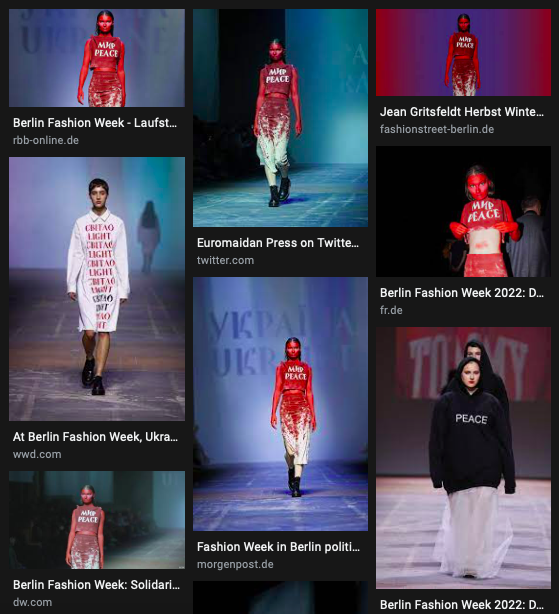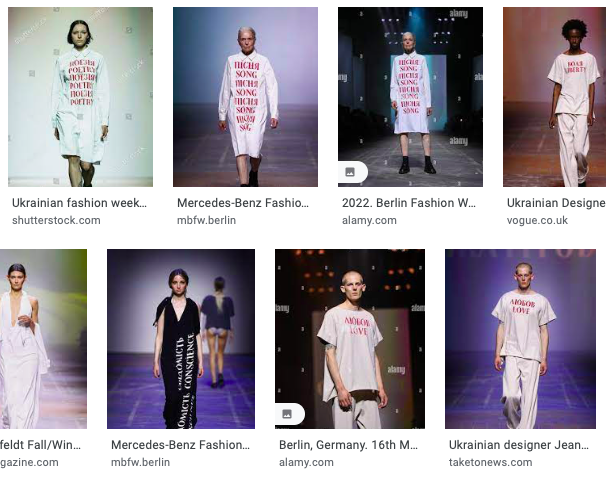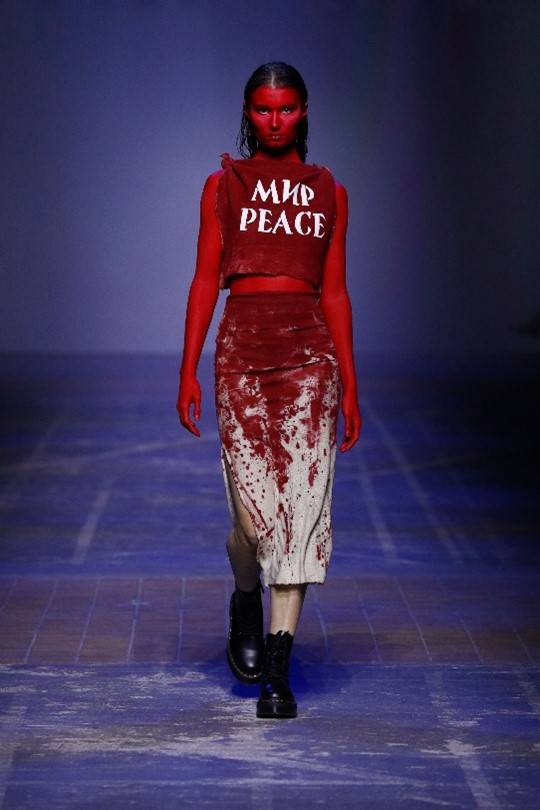
Fashion is arguably one of the most creative and complete art forms. Fashion shows combine the materiality and visual design of more traditional art forms such as drawing, painting and sculpting, while also drawing inspiration from performing arts, via the music tracks for the show and the body language, dance and performances of the models. It can also include meta-literary elements, thus being able to incorporate elements from literature as well. In short, the relevance of fashion, especially in our contemporary times, cannot be simply reduced to a response to consumerism, or a plain display of vanity; it is a powerful tool to communicate the designer’s interiority and provides excellent grounds for social commentary.
Fashion designers undoubtedly have the power to create stark, complex and shocking shows, either for simple impact or to carry deeper political or ideological messages. Experimentation with unusual styles or textiles can be deployed to puzzle the viewer and stimulate discussion on the meaning of clothes, as if they were an enigmatic painting. This has long been a trademark feature of the work of Jean Gritsfeldt, one of the most renowned and respected Ukrainian design brands worldwide. While his style is not necessarily eccentric or avant-garde, it is considered to be innovative and eye-catching.
This was certainly the case for his SS17 collection and his FW 17/18 collection, with a general trend of overlapping patterns, ostentatious crystals and complex geometry.[1] On the occasion of the Berlin Fashion Week of 2022, Jean Gritsfeldt did not abandon his ability to create designs that capture the spectator’s attention; but he symbolically eliminated opulence and elegant aesthetics from his designs, as a historically conscious choice and a call for political activism. His Fall/Winter collection became a political protest and manifesto, more than a fashion show.[2]
It is impressive to learn about how the show was created. As Gritsfeldt himself has explained, his original idea was completely different; but he felt the urgency to change the entire collection to reflect the political and human catastrophe caused by Russia’s invasion of Ukraine on 24th February 2022:
“We had one day to do the sketches, to complete the mood boards. My colleague who helped me was sitting in a bomb shelter; the lights would switch on and off. Now thinking about it I don’t even know how we made it happen”.[3].
Jean Gritsfeldt in “‘Fashion Should Talk about Important Things’: Ukrainian Designer Jean Gritsfeldt on His Powerful Show.” Vogue, Vogue, 1 Apr. 2022.

Gritsfeldt’s creative expression in his 2022 fashion collection is not just a demand for wider political awareness but also an intimate reflection on a current issue which is affecting him directly as a person. This personal element perhaps explains why the fashion show represents peace in a disturbing as well as hopeful manner. It does not paint an idyllic, stereotypical vision of a flawless paradise, but a mid-conflict reality which undoubtedly bears the weight of human losses. At the same time as highlighting key values which might embody or help to build peace – and Ukraine itself – the clothing testifies to the absence of peace and the human costs of war. In other words, this fashion show represents an urgent call for peace, rather than a clearly pictured reality. This unsettling and tragic approach to representing peace is fully understandable given the urgency of the historical moment that Gritsfeldt was encapsulating in his designs. The result is a gut-wrenching fashion show that represents both the terrible impact of the war in Ukraine and the desire for a better future ahead.
The collection is mostly made of casual wear, in neutral colours, with prints of words in capital letters standing out on the garments, written in English and Ukrainian.[3] The first models on the catwalk during the show wore the simple word ‘Ukraine’, but over time words like ‘conscience’, ‘respect’, ‘unity’, ‘love’, liberty’, ‘beauty’, ‘voice’, ‘poetry’ and ‘song’ replaced them. Notably, when ‘peace’ came out onto the catwalk, the model’s clothes (and the model herself) looked as if they had been drenched in blood – suggesting either a shattered peace or the cost on people’s lives that comes with fighting for it. The original colour of her clothing – white, a colour traditionally associated with peace – reinforced the sense of a sudden, unexpected clash between peace and war. This strong image, Gritsfeldt stated, ‘is symbolic of us paying for peace with our blood’.[4]
The simplicity of the clothes allowed for the straightforward yet hard-hitting messages about war and peace to stand out, further reinforced by the Ukrainian flag being carried by the models at the end of the show. It was a message of solidarity, but also a representation of trauma, with powerful words of hope envisioning a post-conflict future. This duality of peace messages alongside strong conflict imagery generated a strong emotional reaction in the audience, as Gritsfeldt disclosed to Vogue: ‘After the show, people didn’t want to go—they were just crying. Maybe because they felt it wasn’t about the clothes; it was about what we were feeling.'[5] This is indicative of how fashion can be used as a medium to express an urgent need for peace. Moving beyond the usually luxurious abstractions of fashion shows, Gritsfeldt’s collection represents the sacrifice of Ukrainians as victims of war and also as a people fiercely resisting it.
It is interesting to draw parallels with the Balmain’s Fall/Winter fashion show, organised for the 2022 Paris Fashion Week. In Balmain’s collection, we can see the communicative power of fashion, and its applicability to real-life issues. Balmain’s concept behind the show undoubtedly touches on issues of security: the desire for a more peaceful world is a crucial element of the creative process behind the show of creative director of the collection, Oliver Rousteing.[6]
The performative elements of the Balmain’s show allow for the expression of an intimate, yet widely common experience of security. Speaking of the carefully curated music for the show, two songs particularly stand out – Rosalía’s “A Palé” and Grace Jones’ “This is”. These two tracks are complementary both in sound and in lyrics; I believe they both contain elements of R&B, creating a somewhat dream-like atmosphere. However, it is the text that creates the strongest similarity, as both songs have, as a pivotal element, the importance of individual agency in protecting oneself. “A Palé”, for instance, talks about a constellation which the singer presumably interprets as an omen of security which she carries and whose responsibility (and merit) is exclusively hers.[7] Similarly, Grace Jones’ lyrics emphasise the importance of determination in speaking out for themselves and using voice as a weapon.[8] Therefore, while both artists acknowledge the existence of a danger from which the individual must protect themselves, there is not fear, but encouragement to face such difficulties, relying on their own power to protect them. This positive take is also shared by the choreography that opens the show, with dancers dressed as soldiers facing each other in two separate crews, approaching one another menacingly. What initially looks like a conflictual dance turns into a powerful, peaceful encounter, with the two groups coming together in a pyramid whose apex is represented by two soldiers kissing. This profoundly meaningful dance serves as the prelude of the fashion show, which exhibits bulletproof jackets worn as corsets, perhaps a hint to the recent fashion trends that look back to the Regency Era as an occasion for escapism, a desire and melancholy for (supposedly) simpler times, far from the social isolation of technology, in a fairytale-like setting which has dictated the latest fashion trends.[9] The aim of the fashion show is, in fact, to envision the necessity for defence mechanisms against body dysmorphia caused by the excessive presence of social media in our daily lives.[10]
This is the original interpretation of Rousteing’s collection6, however this has not prevented fashion magazines and reporters of the Fashion Week to see this fashion show as a manifestation of support for Ukraine. The creative director has in fact dismissed this interpretation6, given that the collection had been thought of months before Russia’s invasion of Ukraine borders, however this does not mean that the peaceful message of this show cannot be applied to a more universal desire for the end of conflict,[11] both in our daily lives and in international matters.
What do you think?
- What role can fashion play in shaping how we visualise both war and peace?
- Can fashion be seen as a form of artivism?
- What difference has Gritsfeldt’s closeness to the war in Ukraine potentially made to how he has visualised peace in his 2022 collection? And how might this ‘insider’ perspective change the discourse around possibilities for future peace?
- How does the Balmain fashion show compare?
- If you were designing clothing to represent or promote peace, what would it look like?
If you enjoyed this item in our museum…
You might also enjoy ‘Pockets of Peace in Ukraine‘, ‘Utopia/Dystopia‘, ‘Valentino’s Peace Dress‘, ‘Souvenir Official‘, ‘Two Neighbours‘ and other items with the tag ‘Artivism‘.
Federica Consiglio, May 2022
[1] Pashkevich, Kalina. “The Analysis of De Luxe Clothing in the Collections of World and Ukrainian Designers.” National Academy of Managerial Staff of Culture and Arts Herald, no. 3, 2018, https://doi.org/10.32461/2226-3209.3.2019.191799.
[2] Gritsfeldt, Jean in “‘Fashion Should Talk about Important Things’: Ukrainian Designer Jean Gritsfeldt on His Powerful Show.” Vogue, Vogue, 1 Apr. 2022, https://www.vogue.com/article/ukrainian-designer-jean-gritsfeldt-on-his-fall-2022-show: ‘I wouldn’t even call it a fashion show—it was more like a manifesto; about making a statement. It was about creating this unity around what is happening right now and saying, “Please, we need your support.”’
[3] To watch the show, follow this link: https://youtu.be/xa5fwPkwMpM.
[4] Gritsfeldt 2022, ibid.
[5] Ibid.
[6] “ (referring to Oliver Rousteing) penning a note in which he said collection was a “push-back against lies, hate and aggression” — referencing the “anxiety-inducing headlines of the past week.”
“Balmain Calls for Peace and Truth in Paris Fashion Week Show.” The Independent, Independent Digital News and Media, 2 Mar. 2022, https://www.independent.co.uk/news/olivier-rousteing-rihanna-paris-balmain-ukraine-b2027272.html?msclkid=5a736078b37f11ec9dfa948e48145104.
[7] “Desde el dìa en el que nacì, traigo la estrella quel levo, sé que a nadie se la debo, y solo me protege a mì” “Rosalía – A Palé (Official Video).” YouTube, 7 Nov. 2019, https://youtu.be/5zwpwbdGNIk.
[8] “This is what I’m focused on, this is my head on straight, this is the harness, this is the bait, this is me, I’m flying again” and “This is my voice, my weapon of choice”. “Grace Jones – This Is.” YouTube, 25 Jan. 2017, https://youtu.be/92oxbPxzh5s.
[9] To learn more about the importance of power dresses and femininity in Regency fashion, I recommend reading: Cole, Daniel James. “Hierarchy and Seduction in Regency Fashion.pdf.” Persuasions (2012): n. pag. Print.
[10] “Let’s not forget the tattooed suits of male and female bodies in trompe-l’oeil, the ultimate metaphor for the physical obsessions caused by the madness of social media”. Marain, Alexandre. “Highlights of the Balmain Fall-Winter 2022-2023 Show by Olivier Rousteing.” Vogue France, Vogue France, 4 Mar. 2022, https://www.vogue.fr/fashion/article/balmain-fall-winter-2022-2023-show.
[11] Ibid, (Citation by Oliver Rousteing): ““These runway offerings were not designed as a direct response to the recent horrific invasion of our neighbours and I would never dare to even think of comparing the suffering that they are going through right now with the problems that I have had on social media. Still, as we watch the news, my team and I do keep in mind this collection’s message: united in solidarity, we can rely on the power of hope and truth to push back against hate, lies and aggression.”
